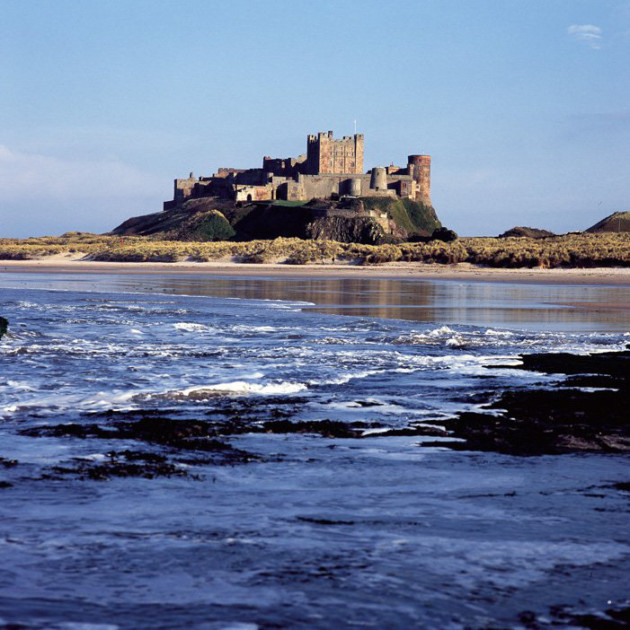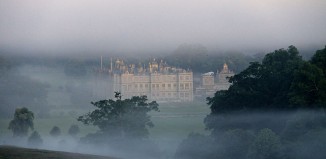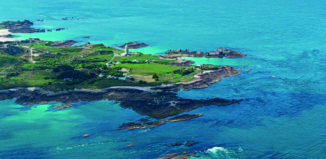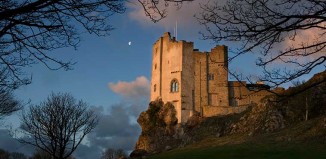Northumberland’s iconic castles
Vicky Sartain
Dunstanburgh Castle
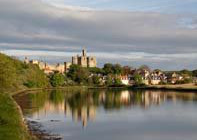
Possibly one of the county’s most iconic castles, Dunstanburgh is little more than a dramatic ruin left behind by its most powerful owner, Edward II. Building work began in 1313 by Thomas of Lancaster, and excavations have shown that the original foundations were even larger than the original site seen today. With added fortification against the Scots, the castle should have been well prepared for the scenes of bloody struggle during the Wars of the Roses, but it was twice captured by Yorkist forces. Towards the end of the Middle Ages, as the castle began to fall into disrepair when the Crown no longer needed it, much of the building stone was removed and used for new projects – but this was not the end of its official duties. The threat of invasion during the Second World War inspired the War Office to act, with an elaborate network of defensive measures set in place in and around the ruins. The view of the fortress is best appreciated from the beach, and many walkers have a prime view of it as they follow the coast path north from the village of Craster.
Tel: 01665 576 007. www.english-heritage.org.uk
Lindisfarne Castle
Situated atop its craggy peak on Holy Island, this small but impressive fort was erected during the reign of Henry VIII. Built largely of stone taken from nearby Lindisfarne Priory, dismantled in the years following its closure in 1537, the castle
held a strategic position for the garrison stationed there in preparation for war against Scotland. In 1543 battleships were moored in the harbour, ready to launch an attack, an act that only succeeded in steeling Scottish resolve. Following the union of England and Scotland in 1603, the castle’s strategic importance waned, as did its garrison numbers during the course of the next century. In 1820 its days as a fort finally ended, and in the 1880s its transformation into a country home commenced when Edward Hudson, proprietor of Country Life, took ownership. The interiors, which Hudson installed, can be enjoyed today on a visitor tour. Designed by Arts and Crafts architect Sir Edward Lutyens, the renovation offers fairytale magic, with rooms immersed in atmosphere beneath arched ceilings, along pillared corridors all with views out to sea through mullion windows.
Tel: 01289 389 244; www.nationaltrust.org.uk/lindisfarne-castle
Warkworth Castle
Rising up in dramatic style above the river Coquet, this medieval fortress first took shape in the 12th century, built by the Earls of Northumberland, a prosperous landowning family. The skeletal remains of the bailey are in contrast to the keep, which benefited from renovation 19th-century renovation. Widely admired for its architectural beauty – a clever design featuring a central tower encompassed by an outer bailey of flamboyant turrets – the castle still reflects days of majesty, when it was owned by Henry II and generations of nobility. As with many castles in this region, its prime purpose was as a defensive base used during the wars with Scotland as well as in the Civil War when Parliamentarian forces set up a garrison there. Despite this, the fort was far from indestructible and fell to rebellion forces in the 14th, 15th and 16th centuries. In the 18th century the gatehouse and tower were demolished and the stone removed to build houses elsewhere. It fell into a ruin of romantic proportions, and Victorian tourists were drawn to its bleak beauty. Keen to expand on this potential, Algernon Percy, 4th Duke of Northumberland employed architect Anthony Salvin’s help in restoring the tower, also rebuilding the keep to make it habitable once again. While the rest of the fortress was taken into state guardianship in 1922, the Percy family kept a handful of rooms for their private use up until 1987. Visitors can explore these rooms and take a free audio tour of the site.
Tel: 01665 711 423; www.english-heritage.org.uk/warkworthcastle
Bamburgh Castle
Bamburgh Castle has been centre stage at key moments in history. Long before its days as a modern-day attraction, the fortress was seen as a symbol of power in a region dogged by hostility, namely from the marauding Vikings. Positioned on the Whin Sill, a great plateau of volcanic rock, the castle dominates the coastal village of Bamburgh and at 45m above sea level, occupants have for centuries scanned the horizon for signs of enemy vessels; in peacetime, views across to the Farne Islands and Lindisfarne are to be savoured. The Whin Sill’s prominence attracted the first settlers from as early as 800BC, and in the first century AD Roman forces turned the lofty heights to their advantage, establishing a coastal defence system. The original fortress, a timber affair, was erected by the Anglos Saxon kings around AD 547. Later, in AD 610 Bamburgh became a royal city and the castle grew in stature in the wake of King Aethelfrith’s rule, a monarch credited with forming the ancient kingdom of Northumbria.
The dawn of the Norman reign saw the castle used as a base for launching attacks against the Scots, and in the 12th century great expense went into its refortification. Henry III remodelled the interiors into a more habitable base, installing glass windows and male and female chambers. When its ability to stave off rebellion failed during the Wars of the Roses, its days as a fortress were numbered; it was the first castle in England to fall to canon fire.
Royal ownership finally ended in 1610 when James I handed the castle to Claudius Forster in thanks for his loyal service to the Crown. Recent history documents a series of owners comprising philanthropists and industrialists who each left their mark. Today’s visitors can tour the interiors – examining the collections of its owners since the early 17th century, from works of art to armoury – before stepping outside to enjoy the grounds and those wonderful views.
Tel: 01668 214 515. www.bamburghcastle.com
Alnwick Castle
Equally celebrated for its spectacular grounds as much as for the imposing fortress itself, Alnwick Castle has double the wow factor. Still privately owned by the Duke of Northumberland, the fortress has been home to the landowning Percy family for 700 years. Perhaps the most famous member of the family was Harry ‘Hotspur’ Percy, who was born at the castle in 1364, and whose likeness can be seen in one of the castle courtyards astride a rearing stone horse. Hotspur fought bravely against the Scots while only a teenager and became so renowned for his battlefield prowess that he was immortalised by Shakespeare.
Among the collections in the property are show-stopping State Rooms with furnishings amassed by the Percy dynasty. Look out for the 1st Duchess Collection, an exhibition of curiosities, art and statuary collected by 18th-century noblewoman Elizabeth, and paintings by Titian, Turner and Canaletto. For an altogether novel experience head into the subterranean world beneath the castle and enter the Lost Cellars thought to have housed some unfortunate prisoners of the Crown.
Outside, the glorious gardens offer year round spectacle and activity. Restored just 10 years ago, this inspiring landscape is a haven, from the tranquil Ornamental Garden to the lofty tree house, complete with restaurant!
Tel: 01665 510 777; www.alnwickcastle.com

